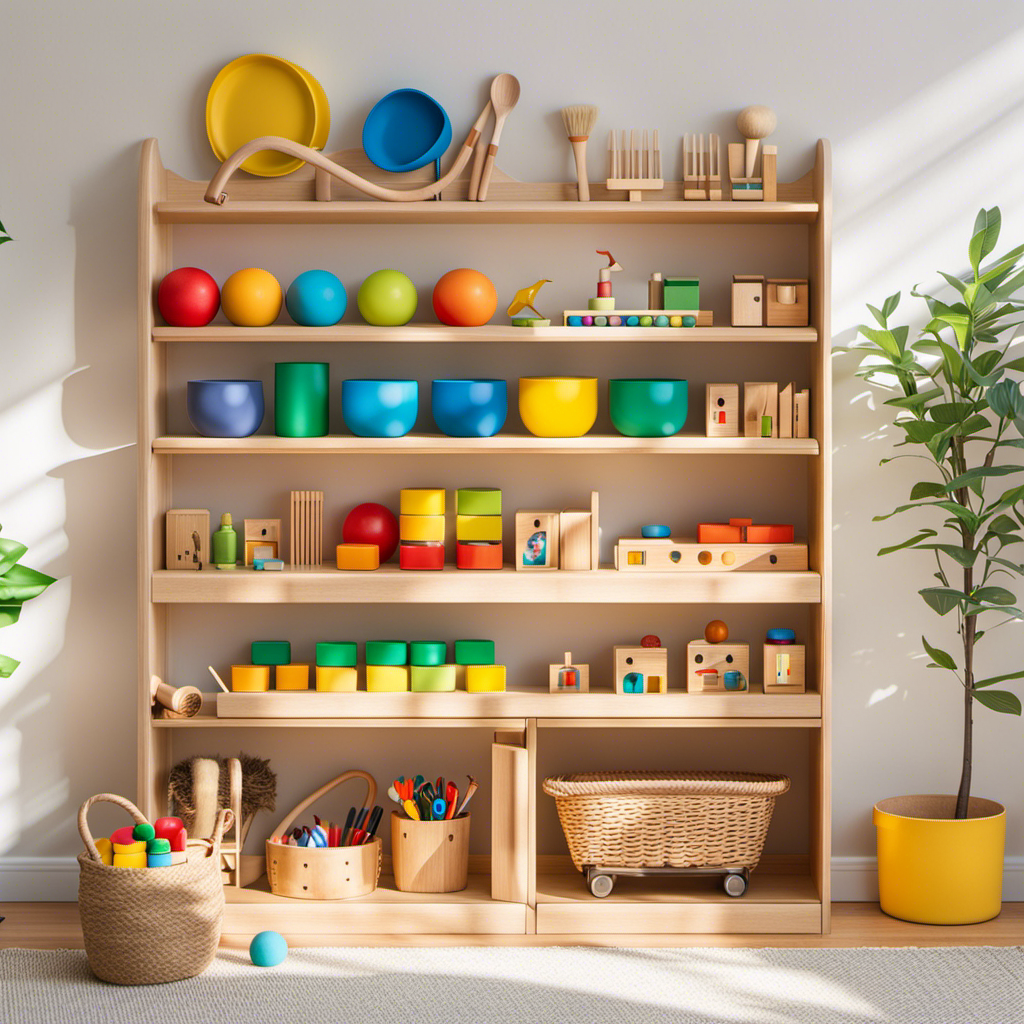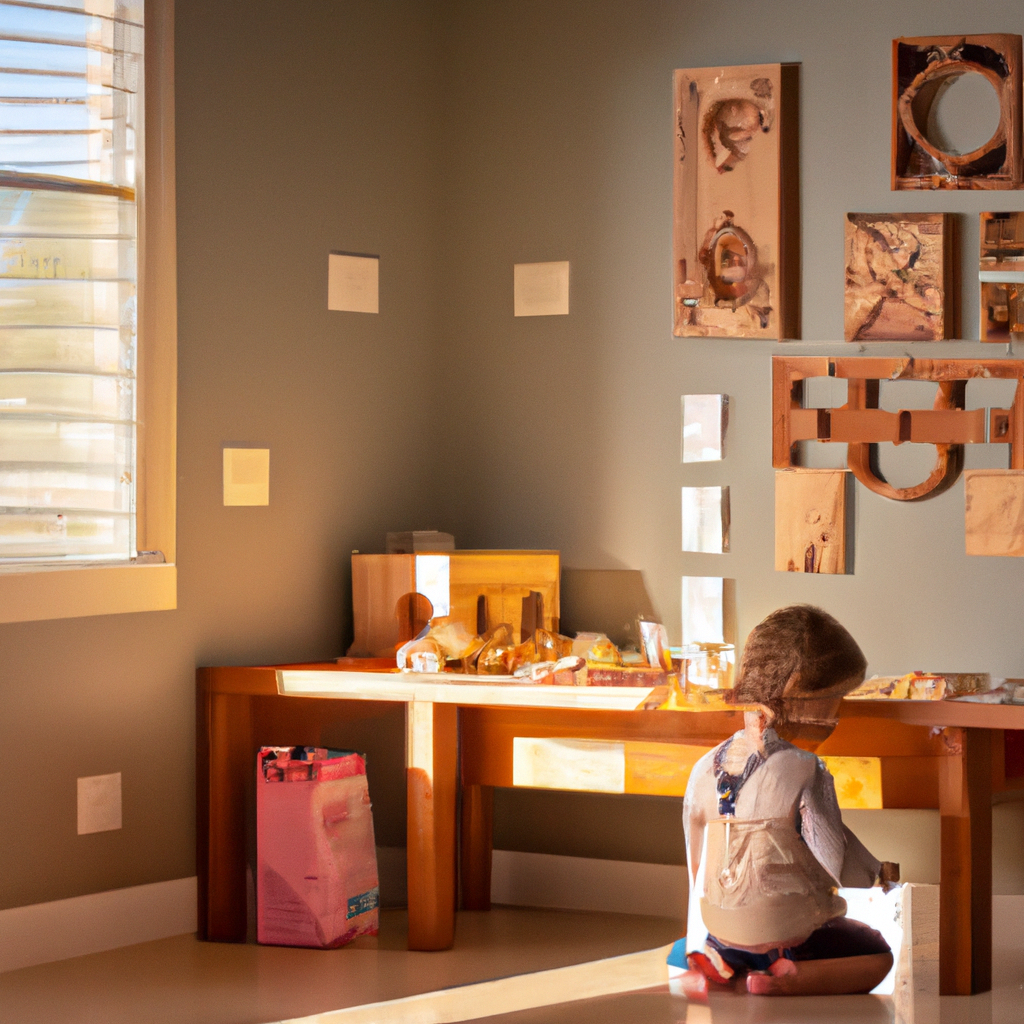To set up a Montessori playroom at home, choose natural, simple materials like wooden toys, fabrics, and glass jars that invite tactile exploration. Organize the space with low shelves at your child’s eye level, keeping materials accessible and clearly grouped to encourage independence. Design areas for different activities, minimize clutter, and create an inviting environment that promotes curiosity and self-directed play. Exploring these steps further will help you create a space that truly supports your child’s growth.
Key Takeaways
- Use natural materials like wood, fabric, and glass to encourage tactile exploration and environmental awareness.
- Organize the space with low shelves and accessible storage to promote independence and easy choice-making.
- Select simple, high-quality items that invite manipulation and real-world interaction, avoiding plastic or overly synthetic toys.
- Design an inviting environment with minimal clutter, encouraging free, spontaneous exploration without adult interference.
- Incorporate child-led activities by providing open-ended materials that support curiosity, decision-making, and confidence building.

Creating a Montessori playroom at home can be a rewarding way to encourage your child’s independence and love of learning. The key is to design an environment that promotes exploration through child-led activities and utilizes natural materials. When you focus on child-led activities, you’re empowering your child to choose what interests them, fostering curiosity and self-motivation. Instead of imposing a strict schedule or predetermined activities, you set up a space where your child can select tasks that resonate with their current interests, whether it’s pouring water, sorting objects, or building with blocks. This approach helps develop decision-making skills and confidence as they navigate their choices.
Natural materials play a crucial role in creating an authentic Montessori environment. Opt for wooden toys, silk scarves, cotton fabrics, and other natural elements instead of plastic or synthetic substitutes. These materials are tactile, durable, and aesthetically calming, which helps your child focus and engage deeply. Natural materials also introduce your child to the beauty and textures of the natural world, nurturing their sensory development and environmental awareness. When choosing items for the playroom, look for simple, high-quality pieces that invite manipulation and exploration, like a wooden balance scale, glass jars, or metal utensils. These items not only stand the test of time but also promote meaningful, real-world experiences.
To facilitate child-led activities, organize the space thoughtfully. Use low shelves and accessible storage so your child can independently select and return items. Keep materials within easy reach—at their eye level—to encourage autonomy. Group similar items together to make choices straightforward, and avoid clutter to help your child focus on one activity at a time. For example, have a dedicated area for arts and crafts with natural paper, crayons, and clay, and another for practical life activities like pouring or sweeping. The goal is to create an inviting environment that invites your child to explore freely without unnecessary distractions or adult interference.
Frequently Asked Questions
How Do I Choose Age-Appropriate Montessori Materials?
When choosing age-appropriate materials, you should focus on the child’s developmental stage. Look for Montessori selection that matches their current abilities and interests, ensuring the materials are neither too easy nor too challenging. Observe how your child interacts with different items, and adjust as they grow. This approach helps foster independence, concentration, and a love of learning, making sure your child benefits fully from their Montessori environment.
What Safety Precautions Are Essential for a Home Montessori Playroom?
Think of your playroom as a safe garden where your child can explore. You should place a fire extinguisher in an accessible spot and make certain it’s visible. Cover electrical outlets with child-proof outlet covers to prevent accidents. Keep small objects out of reach and secure any furniture that could tip over. Regularly check for hazards and teach your little one about safe play, creating a secure environment for growth and discovery.
How Can I Organize the Space for Maximum Accessibility?
To organize your space for maximum accessibility, use simple storage solutions like low shelves and baskets that children can easily reach. Incorporate visual cues such as labels or color coding to help your child identify and select activities independently. Keep everything at their eye level, and guarantee open space for movement. This setup encourages independence and makes cleanup easier, fostering a sense of order and confidence in your child.
What Budget-Friendly DIY Montessori Activities Can I Include?
You can include budget-friendly DIY Montessori activities using DIY sensory experiences and recycled materials. Create a sensory bin with rice or pasta and add small, safe objects for exploration. Use recycled jars or cardboard for stacking and sorting games. These activities promote independent learning and are cost-effective. Incorporate everyday items, like old buttons or fabric scraps, to craft engaging, eco-friendly activities that develop your child’s fine motor skills and curiosity.
How Can I Encourage Independent Play in My Child?
To promote independent play, prioritize patience and provide a peaceful, purposefully prepared space. Encourage your child’s curiosity through open-ended activities that foster independent exploration and self-directed learning. Limit distractions to help your child focus, and praise their efforts to build confidence. By creating a calm and consistent environment, you empower your little one to confidently explore, experiment, and enjoy independent play, nurturing their natural desire to learn and grow.
Conclusion
Now that you’ve set up your Montessori playroom, you’re well on your way to fostering independence and curiosity. Remember, a well-organized space can make all the difference in your child’s development. Keep it simple, inviting, and accessible, so they can truly thrive. As the saying goes, a little preparation now can save a lot of trouble later—turning your home into a nurturing hub of learning and growth.
Mila, a gifted writer with a heart brimming with enthusiasm for child development and playful learning, is the creative force behind the enchanting narratives and insightful articles that grace Toddler Ride On Toys. With a background in early childhood education and a genuine passion for nurturing young minds, Mila weaves words that captivate, educate, and inspire parents, caregivers, and educators.










